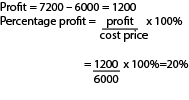
Trading, profit, loss, discount and shopping – primary mathematics

Trading
A trader is a person who buys commodities and sells them at a profit.
The profit is the difference between the selling and cost prices
i.e. profit = selling price – cost price
![]()
When the selling price is lower than the cost price a trader makes a loss.
Loss = cost price – selling price ( where the cost price is higher than the selling price)
![]()
Discount
When a buyer buys many commodities from a trader, a trader may make some reduction on the prices. The reduction in price or cost of a commodity is called a discount.
Discount = cost of commodity – money agreed on to be paid by the buyer
![]()
Total cost of items = sum of the cost of all the purchased items.
Balance = Money paid by the trader – Total cost commodities (this money is returned to the buyer)
Unit cost is the cost of one item when the items are bought in a bundle or group.
Or
Cost of items = unit cost x number of items
Example 1
Saudah bought a dress at sh 6,000 and sold it at sh 7,200. What was her percentage profit?

Example 2
A businessman sold a generator at Shs. 200,000 making a loss of 1,500.
What was the cost price of the generator?
Cost = sale price + loss
= 200,000 + 10,500
= 210, 500
Example 3
A customer bought a fountain pen at Sh 1,500. The original price of the pen was Sh 2,000.
- Work out the percentage discount.

(b) If the customer was allowed the same percentage of discount on an article priced at Sh 5,000, how much did he pay for it?

Example 4
Six plates cost sh 3,000. What is the cost of four plates?
| 6 plate cost 3000
1 plate cost 4 plate cost 500 x 4 = shs 2000 |
For additional exercise and worked solution; download the PDF below

I’m excited to see where you’ll go next. Indian Cricket
Embark on a fulfilling medical career with the Top MBBS Colleges in Himachal Pradesh.
Find affordable medical education opportunities with MBBS Fees Structure in Rajasthan.
Enjoy exclusive benefits by applying the Raja Luck Invite Code.
Keep yourself updated with new information on Raja Luck.
Make additional credits immediately when you sign up using the 82 Lottery Invite Code.
Strengthen your site’s link profile and Increase website backlinks organically for enduring outcomes.
Enhance enterprise workloads with robust Server Rental in Hyderabad.